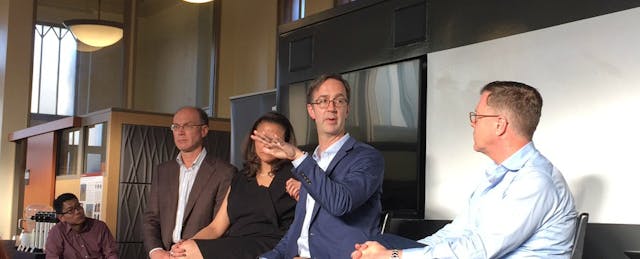For someone who wrote a book titled “The End of College,” Kevin Carey is surprisingly optimistic about the future of higher education. He just thinks it will bear little resemblance to the current model of college in the U.S.
Last night Carey spoke with a panel of faculty and administrators at Stanford University about what higher education might look like in a world beyond traditional colleges and universities. The irony wasn’t lost on the panelists, all of whom work at Stanford.
Carey spoke with Nicole Taylor, associate vice provost and dean of community engagement and diversity, and John Mitchell, vice provost for online learning. Mitchell Stevens, associate professor of organizational behavior in the graduate school of business, moderated the conversation.
As he did in “The End of College,” Carey last night discussed how higher education today falls short: driving $1.3 trillion in student loan debt, serving conflicted interests and ignoring the psychology on how people learn. He also explained his reason for writing the book in the first place: “I was intrigued about why, in a time where information technology has changed the substantive and economic reality of so many different parts of our society, it doesn’t seem to have any impact on how much students are paying.”
For their part, panelists asked what is a university like Stanford, which isn’t failing its students the way that colleges with fewer resources might, can do to make higher education more accessible to more people. No one, Carey included, thought the answer was MOOCs. Instead, he posed a question: “If a university in Stanford’s position decided to be as creative and generous as possible in using information technology to serve as many students as it could as well as it could, what would that look like?”
He challenged Stanford to collaborate with other institutions in the area, from community colleges and trade schools to public research universities for curriculum development for courses taught across campuses. “There is great knowledge at all of these places,” Carey said. “I’m willing to bet there’s not a lot of communication between them.”
Such a consortium could use technology to drive costs down, increase access and improve the quality of higher education at all of the institutions, Carey proposed. But he doesn’t think technology necessarily improves teaching and learning. “I think technology can allow new organizations to happen,” he said. “New organizations can be built in a way they’re a lot better in taking things we already know work in teaching and learning happen everywhere, all the time.” Carey pointed out that higher-ed institutions—new and old—need to do a better job of studying how people learn and feeding that into their processes.
Carey, who met his wife in college and holds both an undergraduate and graduate degree, made clear that he thinks higher-ed institutions will be around for the foreseeable future. “I deeply believe that the best learning environment is one in which people are part of authentic communities, in which they make deep connections with other students, professors, mentors,” he said. In other words, the future of higher ed doesn't look like a solitary learner flipping through assignments on a phone. “I just don’t think those organizations are only the colleges we have today.”


